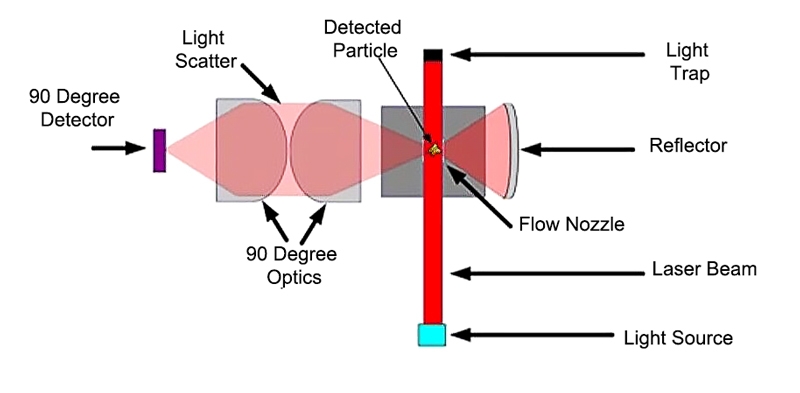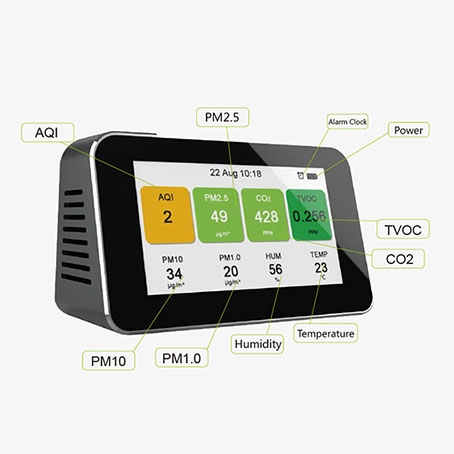An air quality monitor is an instrument used to measure and monitor various pollutants and meteorological parameters in the atmosphere to assess air quality and meteorological conditions. These instruments have a wide range of applications in different fields such as environmental protection, public health, meteorological research, and industrial monitoring. sisco shop will explain in detail how air quality monitors work and how they work to help you better understand their function and importance.
Working Principle
The working principle of an air quality monitor depends on its type and measurement parameters. Different types of air quality monitor use different sensing technologies and methods to measure specific pollutants or meteorological parameters. Here are some common working principles.
Particulate Air Quality Monitors: Particulate air quality monitors typically use methods such as light scattering, laser diffraction, or mass measurement to measure the concentration of particulate matter in the air. These air quality monitors determine the concentration of particulate matter by measuring its scattering or absorption of light. Light scattering techniques involve using a laser or light source to irradiate airborne particulate matter and then measuring the intensity of the scattered light. Laser diffraction techniques use a laser beam to irradiate particulate matter and measure the pattern of diffracted light. Mass measurement methods, on the other hand, determine concentration by trapping particulate matter and measuring its mass.

Indoor Air Quality Monitor: Indoor air quality monitors typically include sensors to measure temperature, humidity, CO2 concentration, and particulate matter concentration. The sensors collect data and transmit it to the monitor's data-logging system for real-time monitoring and analysis.
These air quality monitors use different types of sensors to measure these parameters such as temperature sensors, humidity sensors, wind speed sensors, and barometric pressure sensors.
Working Process
- Parameter Measurement: Depending on the type and settings of the air quality monitor, it starts measuring atmospheric parameters such as particulate matter concentration, gas concentration, temperature, humidity, and so on. Different sensors and technologies are used for the measurement of different parameters.
- Data Acquisition: The air quality monitor collects the measured data, which is usually stored digitally in an internal memory or transferred to a data logging system. Data acquisition can be continuous to provide real-time data or periodic to generate periodic reports.
- Data Analysis: The collected data are analyzed and processed to generate reports on air quality or meteorological conditions. This may include the calculation of average values, maximum values, minimum values, trend analysis, etc.
- Data Transmission: The air quality monitor transmits data to a monitoring center, cloud server, or other data storage device. This can be done via wired or wireless communication.
- Data Display and Reporting: Data can be displayed on the display of the air quality monitor itself or viewed via a web interface. In addition, the AQM can generate reports for user analysis and decision-making.
- Maintenance and Calibration: Air quality monitors require regular maintenance and calibration to ensure accuracy and reliability. This includes cleaning sensors, replacing damaged parts, and calibrating the air quality monitor.
Applications of Air Quality Monitors
Environmental Protection: Used to monitor air pollutants to ensure compliance with emission sources and to protect the environment and human health.
Public Health: For monitoring indoor and outdoor air quality to prevent respiratory diseases and other health problems.
Meteorological Research: For collecting meteorological data to develop weather forecasts, meteorological research, and climate change monitoring.
Industrial Monitoring: For industrial process control and emission source monitoring to ensure the safety and environmental friendliness of industrial production processes.
Mobile Monitoring: For emergency response, short-term projects, and research activities to quickly monitor pollution incidents and air quality issues.
Indoor Air Quality Improvement: For monitoring temperature, humidity, CO2 concentration, and particulate concentration in indoor environments to improve indoor air quality.
Air quality monitors are a combination of multiple sensing technologies and methods for measuring atmospheric and meteorological parameters. These high quality air quality monitors play an important role in a variety of applications to help us protect our health, environment, and resources. By continually improving the performance and accuracy of the monitors, we can better address air quality and meteorological issues to achieve sustainable development and a healthier future.

